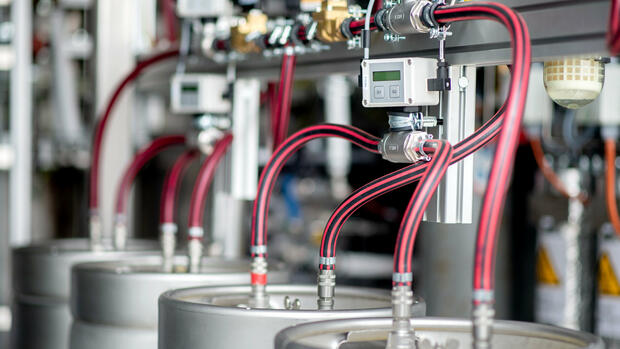Dusseldorf Over 300 billion US dollars are to flow into green hydrogen worldwide by 2030. The problem: So far, it has mainly been with announcements. Just 29 billion dollars are a done deal.
The companies are waiting: for political decisions, for calculable prices and for fixed contracts. Thyssen-Krupp’s hydrogen subsidiary has also waited a long time. Now Nucera is getting serious and going public with the business that manufactures electrolysers for the production of the coveted molecule.
Compared to other manufacturers of electrolysers, things are currently looking promising: Nucera supplies electrolysers to the Swedish steel manufacturer H2 Green Steel, builds electrolysers for Air Products in Saudi Arabia, Unigel in Brazil and for Shell in the port of Rotterdam.
But although Nucera is currently ahead of its competitors with its orders, the entire production of hydrogen is still very manageable. This becomes clear when you look at the actual production figures in Germany. There is just 0.1 gigawatts of installed electrolysis capacity in Germany in mid-2023. Ten gigawatts are planned by 2030, but Germany is a long way from that.
According to industry insiders, the lack of final investment decisions in particular is holding back the industry. Companies like RWE or Sunfire have now been waiting almost two years for the funding decision from Brussels. But it is not only in Europe that things are sluggish.
Nucera is one of the global players in a market that actually isn’t one yet. The green technology of the future is ramping up more slowly than expected. There is great uncertainty, especially for companies like Nucera, observes hydrogen expert Michael Sterner from the Technical University in Regensburg.
“Real risk” of not achieving expansion targets
“There are currently very many who need hydrogen and few who supply it,” says Sterner of the Handelsblatt. Tight supply chains, labor shortages, rising inflation and interest rates, and a lack of subsidies in many markets are holding back green technology.
This is shown by current figures from the lobby organization “Hydrogen Council”. 38 million tons of capacity are announced worldwide by 2030. Today there is just well under a million tons of actual installed green hydrogen production capacity around the world. More than 90 percent of the hydrogen requirement is currently still covered by fossil sources. Green hydrogen should be an important building block for the global energy transition.
>> Read here: Winners of the boom: Four regions could produce almost half of the hydrogen
With the so-called Power-to-X technology for the production of green hydrogen, water is broken down into its components oxygen and hydrogen using the process of electrolysis using green electricity from wind and sun. Experts currently see the greatest need for hydrogen in industry, shipping and aviation: wherever the use of a battery is more expensive or difficult.
An industrial nation like Germany would need between 29 and 101 terawatt hours of green hydrogen by 2030 to convert to a green economy. By 2045 it could even be between 200 and 700 terawatt hours. This is the result of a current analysis by the Wuppertal Institute for Climate, Environment and Energy on behalf of the North Rhine-Westphalia State Association for Renewable Energies.
“There is a real risk that we will not achieve the announced expansion targets for electrolysers,” warns Sterner. On the one hand, this is due to the lack of framework conditions and excessively long approval processes in Europe.
However, there is also great uncertainty worldwide as to whether the climate targets will be relaxed further or not. “Then the result can be that a great disillusionment spreads in society and we focus more on adaptation than avoidance. And for cost reasons, many measures come before hydrogen,” says Sterner.
Hydrogen company prices are under pressure
At least on the stock exchanges, the hype of the past few months has subsided considerably. Price favorites such as hydrogen group Nel Asa from Norway have lost over 23 percent within a year. The British competitor ITM Power is even over 60 percent. This also applies to US companies such as Plug Power. Despite the multi-billion dollar subsidy program from Washington, the price of the fuel cell specialist has fallen by almost 50 percent over the past twelve months.
According to experts, a course correction is currently taking place on the market for the production of hydrogen: the gold rush mood is subsiding after many companies were rated disproportionately high as a result. However, the promised growth did not materialize so quickly – because the hydrogen ramp-up and related projects took longer than initially calculated. As a result, prices have been falling for months now.
In addition, the USA is now more attractive to investors than Europe. In the United States, the Inflation Reduction Act (IRA) anti-inflation program offers subsidies and tax breaks. Nucera also wants to focus primarily on North America for future business development, a spokeswoman said when announcing the IPO.
According to the company, North America is a favorable location precisely because the US anti-inflation program offers a number of advantages. “The legal situation there is more advantageous for electrolyser manufacturers than in the rest of the world.”
More: Demand for IPO of Thyssen-Krupp subsidiary exceeds supply.

